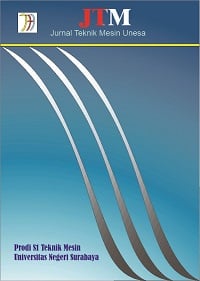PENGARUH VARIASI ARUS DAN CLAMPING TERHADAP DISTORSI PADA PENGELASAN BAJA ST37 KETEBALAN 2,5MM
Abstract
This study aims to investigate the effect of welding current variation and the use of clamping on angular distortion in the welding of 2.5 mm thick ST37 steel plates using the Shielded Metal Arc Welding (SMAW) method. The experimental research was conducted at the Mechanical Engineering Laboratory of Politeknik Negeri Malang, using three different current levels: 20 A, 30 A, and 40 A. Welding was performed under two conditions: with and without clamping. Distortion data were collected using a dial indicator and converted into degrees to represent angular deformation. The results show that increasing the welding current leads to higher angular distortion, particularly under the non-clamping condition. On the other hand, the application of clamping significantly reduced the distortion values at all current levels, even producing negative distortion at the highest current. Statistical analysis using the independent sample t-test confirmed that clamping had a significant effect at 30 A and 40 A. This study concludes that the optimal combination of welding current (30 A) and clamping can effectively minimize angular distortion in thin steel plate welding using the SMAW process.
Keywords: SMAW welding, angular distortion, welding current, clamping, ST37 steel
Downloads
Downloads
Published
Issue
Section
 Abstract views: 55
,
Abstract views: 55
, PDF Downloads: 75
PDF Downloads: 75


